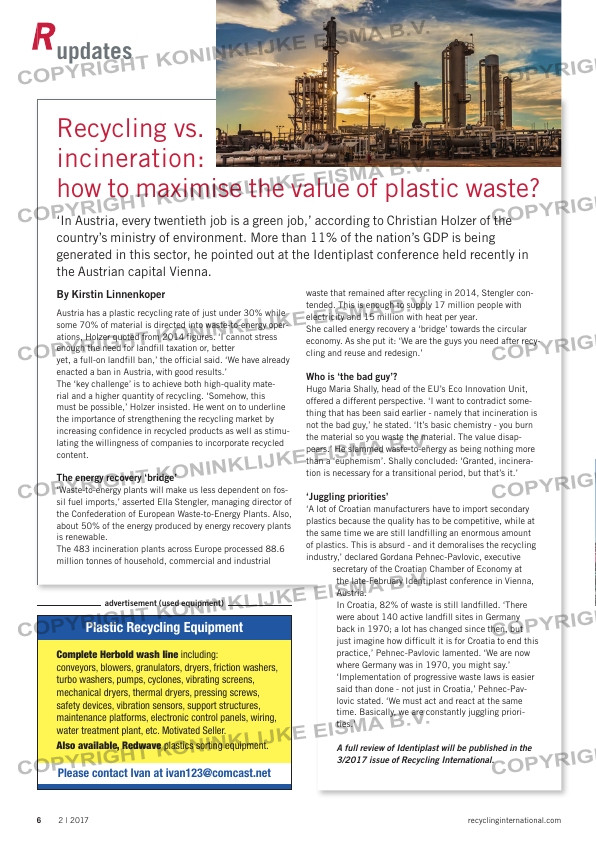Page 8 from: Edition 2 2017

6 2 | 2017
updates
recyclinginternational.com
Recycling vs.
incineration:
how to maximise the value of plastic waste?
‘In Austria, every twentieth job is a green job,’ according to Christian Holzer of the
country’s ministry of environment. More than 11% of the nation’s GDP is being
generated in this sector, he pointed out at the Identiplast conference held recently in
the Austrian capital Vienna.
By Kirstin Linnenkoper
Austria has a plastic recycling rate of just under 30% while
some 70% of material is directed into waste-to-energy oper-
ations, Holzer quoted from 2014 figures. ‘I cannot stress
enough the need for landfill taxation or, better
yet, a full-on landfill ban,’ the official said. ‘We have already
enacted a ban in Austria, with good results.’
The ‘key challenge’ is to achieve both high-quality mate-
rial and a higher quantity of recycling. ‘Somehow, this
must be possible,’ Holzer insisted. He went on to underline
the importance of strengthening the recycling market by
increasing confidence in recycled products as well as stimu-
lating the willingness of companies to incorporate recycled
content.
The energy recovery ‘bridge’
‘Waste-to-energy plants will make us less dependent on fos-
sil fuel imports,’ asserted Ella Stengler, managing director of
the Confederation of European Waste-to-Energy Plants. Also,
about 50% of the energy produced by energy recovery plants
is renewable.
The 483 incineration plants across Europe processed 88.6
million tonnes of household, commercial and industrial
waste that remained after recycling in 2014, Stengler con-
tended. This is enough to supply 17 million people with
electricity and 15 million with heat per year.
She called energy recovery a ‘bridge’ towards the circular
economy. As she put it: ‘We are the guys you need after recy-
cling and reuse and redesign.’
Who is ‘the bad guy’?
Hugo Maria Shally, head of the EU’s Eco Innovation Unit,
offered a different perspective. ‘I want to contradict some-
thing that has been said earlier – namely that incineration is
not the bad guy,’ he stated. ‘It’s basic chemistry – you burn
the material so you waste the material. The value disap-
pears.’ He slammed waste-to-energy as being nothing more
than a ‘euphemism’. Shally concluded: ‘Granted, incinera-
tion is necessary for a transitional period, but that’s it.’
‘Juggling priorities’
‘A lot of Croatian manufacturers have to import secondary
plastics because the quality has to be competitive, while at
the same time we are still landfilling an enormous amount
of plastics. This is absurd – and it demoralises the recycling
industry,’ declared Gordana Pehnec-Pavlovic, executive
secretary of the Croatian Chamber of Economy at
the late-February Identiplast conference in Vienna,
Austria.
In Croatia, 82% of waste is still landfilled. ‘There
were about 140 active landfill sites in Germany
back in 1970; a lot has changed since then, but
just imagine how difficult it is for Croatia to end this
practice,’ Pehnec-Pavlovic lamented. ‘We are now
where Germany was in 1970, you might say.’
‘Implementation of progressive waste laws is easier
said than done – not just in Croatia,’ Pehnec-Pav-
lovic stated. ‘We must act and react at the same
time. Basically, we are constantly juggling priori-
ties.’
A full review of Identiplast will be published in the
3/2017 issue of Recycling International.
advertisement (used equipment)
Plastic Recycling Equipment
Complete Herbold wash line including:
conveyors, blowers, granulators, dryers, friction washers,
turbo washers, pumps, cyclones, vibrating screens,
mechanical dryers, thermal dryers, pressing screws,
safety devices, vibration sensors, support structures,
maintenance platforms, electronic control panels, wiring,
water treatment plant, etc. Motivated Seller.
Also available, Redwave plastics sorting equipment.
Please contact Ivan at [email protected]



